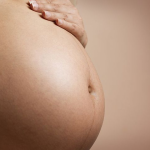Pregnancy comes with many physiological and anatomical, biochemical, systemic or local changes in the body in order to meet the needs of the developing fetus in the uterus. These changes tend to maintain a healthy environment for the fetus without compromising the mother’s health. They also help to prepare for the process of delivery and care of the newborn. These changes are caused by hormones involved in pregnancy. However, most of the systemic changes return to pregravid state 6 weeks after delivery. I will discuss these changes system by system for detailed information and easier understanding as proper understanding helps to distinguish normal changes from coincidental disease processes: Reproductive system: Uterus: Prior to pregnancy, uterus is a small, almost solid, pear shaped organ about 7.5x5x2.5cm and weighing about 60 g, volume 10ml. At the end of pregnancy, it measures about 28x24x21cm and weighs approximately 1100g at term. During pregnancy, the uterus is divided into two functional portions either above or below the isthmus and are called upper and lower uterine segments respectively. Its capacity increases from about 10ml to 5,000ml (5litres) or more at term. These are due to enlargement (hypertrophy) of the myometrial cells due to estrogen and distension by the growing fetus and build up of new cells via hyperplasia . The upper part,fundus and body become the upper uterine segment. Fibrous tissue in the muscle increases markedly. Oviducts (fallopian tubes) are lifted with the uterus as it grows. The enlarging uterus, placenta and growing fetus requires additional blood flow. So by the end of pregnancy, one sixth of the total maternal blood volume is contained in the vascular system of the uterus. Braxton Hicks contractions also occur in the uterus intermittently Throughout pregnancy. They are irregular painless contractions that may be felt through the abdominal wall from about the fourth month. In later months, Braxton Hicks contractions become uncomfortable and may be confused with true labor contractions. Cervix: Estrogen stimulates the glandular tissue which increases in cell number and becomes hyperactive. Gravid cervix is soft and purple while the non-gravid cervix is firm and pink. The endocervical gland secretes thick, sticky mucus that forms the mucous plug, which seals the endocervical canal and prevents the ascent of the organism into the uterus. The mucuous plug is expelled when cervical dilatation begins, known as “show”. Lower part of the uterus, cervix and isthmus become the lower uterine segment. The hyperactive glandular tissue also increases the normal physiological mucorrhea resulting in profuse discharge. Increased cervical vascularity also causes both the softening of the cervix (Goodell’s sign) and its bluish discoloration (Chadwick’s sign). Ovaries: They stop producing oval during pregnancy, but the corpus luteum continues to produce hormones until about weeks 6-8 gestation. Progesterone secreted by the corpus luteum maintains the endometrium until about the seventh week of pregnancy when the placenta assumes the task. Then the corpus luteum begins to disintegrate slowly. Vagina: Oestrogen causes the thickening of the vagina/mucosa, a loosening of the connective tissue and an increase in vagina secretion, known as leukorrhea of pregnancy . Vagina increases in capacity and length secondary to the hypertrophy of the lining epithelium and muscle layer. Increased glycogen content in the wall secondary to the effect of estrogen. This may favours yeast infections. The secretions of vagina during pregnancy are white, thick and acidic (PH 3-5 to 6.0). The acid PH prevents infection but favours yeast organisms. Thus, the pregnant woman is more susceptible to monilial infection. The supportive connective tissue of the vagina loosen throughout pregnancy that by the end of pregnancy, the vagina and perineal body have relaxed enough to permit the passage of the infant. Increased vascularity (blood flow) may show the same purple/bluish colour (Chadwick’s sign) as the cervix. Osiander’s sign: which is the pulsation of fornices. Breasts: Changes in breast are noticed as early as 4-6 weeks of pregnancy especially in primigravida. There is an increased vascularity of the breasts in pregnancy. Oestrogen and progesterone cause many changes in the breasts. The breasts enlarge and become more modular as the gland increases in size and number in preparation for lactation. Nipples become more erectile and the areola pigmentation(darkens). There is also a prominent superficial vein. Montgomery’s follicles (sebaceous glands) enlarge. Striae (reddish stretch marks) may develop. Colostrums, an antibody yellow secretion leak or expressed during last trimester. Colostrum is present from the 16th week of pregnancy. Few days after childbirth, colostrums gradually convert to mature milk. Change in sexual desire during pregnancy Most women experience sexual desire changes at least to some extent during pregnancy. Fear that coitus would result in early labour and loss of desires due to the increased level of oestrogen During the early pregnancy most women report decrease in libido because of nausea, fatigue, and breast tenderness that follow the first trimester of pregnancy. While during the second trimester, as blood flow to the pelvic area increases to supply the placenta, libido and sexual enjoyment drastically increases. During the third trimester, sexual drive may remain high or it may decline due to difficulty in finding a comfortable position and increasing abdominal size. Changes in Respiratory System during pregnancy: There is an increased oxygen requirement. Volume of air breathed increase 30% to 40%. Progesterone decreases airway resistance, leading to progressive increase in oxygen consumption(15-20% above non pregnant level by term), increased carbon dioxide production. The enlarging uterus presses upward and elevates the diaphragm and the lungs as well.Breathing changes from abdominal to thoracic due to elevated diaphragm. Capillary dilatation occurs in the respiratory route (Nasopharynx, larynx, trachea, bronchi) which makes breathing difficult through the nose. Nasal stuffiness and nose bleeds (epistaxis) because of estrogen induced edema and vascular congestion of the nasal mucosa. Lower ribs flare out and do not fully return to its normal position after delivery. Functional respiratory changes occur in which there is a slight increase in respiratory rate. These changes include 50% increase in minute ventilation, 40% increase in minute tidal volume and there is also






